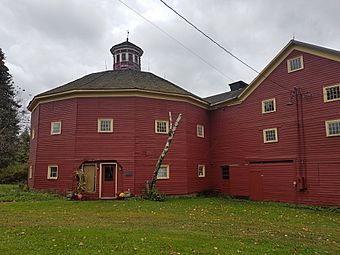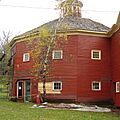Parker 13-Sided Barn facts for kids
Quick facts for kids |
|
|
Parker 13-Sided Barn
|
|

Parker 13-Sided Barn
|
|
| Nearest city | Jefferson, New York |
|---|---|
| Area | less than one acre |
| Built | 1896 |
| Architectural style | 13-sided |
| MPS | Central Plan Dairy Barns of New York TR |
| NRHP reference No. | 84002967 |
| Added to NRHP | September 29, 1984 |
The Parker 13-Sided Barn is a super cool and historic building located in a small place called Jefferson in Schoharie County, New York. You can find it on State Route 10, between Harpersfield and Stamford. This barn is really special because it was built in 1896 and is one of only two 13-sided barns in this area of New York state that are listed on the National Register of Historic Places. It's also known as a type of round barn.
Contents
What Makes This Barn Special?
The Parker Barn is a huge building with three stories. It's about 60 feet wide! Mr. Richtmyer Hubbell built this amazing barn over a hundred years ago. The roof is quite unique, with a "double hipped" design. This means it has two slopes on each side, making it look really interesting. On top of the roof, there's a 13-sided cupola. A cupola is like a small tower or dome that lets light and air into the barn.
Built by the Hubbell Family
Charles Hubbell, a longtime resident of Schoharie County, has many great memories of the barn. He is the grandson of the builder, Mr. Richtmyer Hubbell, and was even born at the homestead surrounding the property. The homestead also includes another large, rectangular barn from the late 1800s. This barn is connected to the 13-sided barn by a small walkway. There's also a beautiful Victorian-style farmhouse on the 15-acre property, which is just outside the Catskill Mountain range.
A Barn with Many Jobs
Over the years, this unique 13-sided barn has been used for many different things on the farm. It started as a dairy barn, where cows lived and produced milk. Later, it became a chicken barn, and finally, it was used for raising veal calves.
From Dairy to Veal
When it was a dairy barn, cows stayed in stalls on the first floor. Horses would pull wagons full of hay up to the second story using a bridge. This bridge led to large doors on the east side of the barn. Once the hay was unloaded, the horses would walk forward around the inside of the barn and exit through the same doors they entered. This was a smart design! It was much safer than having the horses back out, especially on the steep bridge during snowy winters.
Why is it Called the Parker Barn?
The barn is named after William Parker Sr., who owned it when it was officially registered as a landmark. More than 30 years ago, Mr. Parker was raising veal calves there. He also started a big project to fix up and improve the barn. This renovation work caught the attention of the National Registry, which then decided to list the building as a historic place.
Restoring a Piece of History
Today, the Parker Barn is still privately owned. It's slowly being renovated again. The goal is to honor the families who worked hard on this land in the past. The owners also want to make sure future generations can enjoy it. Eventually, they hope to open the barn to the public. This will allow visitors to learn about the rich history that can be found in small towns across America.
The Parker 13-Sided Barn was officially added to the National Register of Historic Places in 1984.
Images for kids








